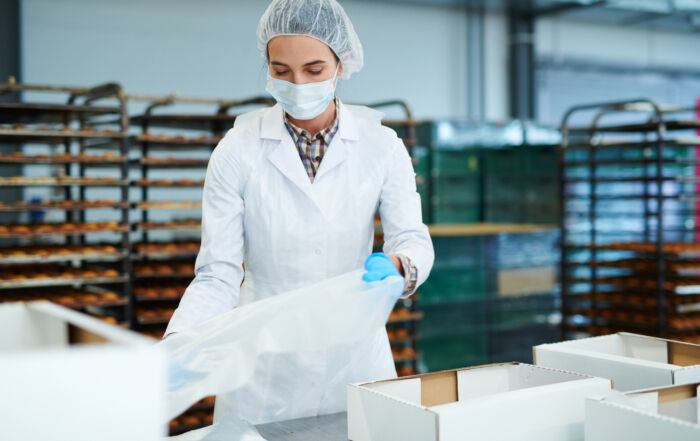The Basic Principles of Food Safety
Every food establishment uses, processes, and sells food in different ways. However, the general issues and key principles of food safety remain the same, whatever the style of the operation. All food safety training programs should contain the “big 3” factors that could cause food to become unsafe. Food must be kept out of harms way from human errors, but if you don’t train food workers what they are, they won’t know why these factors are so important to your operation. The basics can make us or break us in one or maybe two food handling mistakes.
Those basic 3 principles that we must train all managers and food workers about are:
– Personal Hygiene for Food Professionals;
– Time & Temperature Control;
– Cross-contamination Prevention
1. Professional Personal Hygiene – It’s not all common sense to everyone. Food workers must observe the highest possible standards of personal hygiene to make certain that food does not become contaminated by pathogenic microorganisms, physical or chemical hazards. High standards of personal hygiene also play an important part in creating a good public image, as well as protecting food. Handwashing, fingernails, food worker illness policy (including exclusion of ill workers, cuts, burns, bandages, etc.), hair, uniforms, glove use, jewelry, personal cleanliness, or unsanitary habits such as eating, drinking, smoking, or spitting are all parts of defining personal hygiene standards. Poor handwashing is one of the leading causes of foodborne illness.
“Active Hand Hygiene” is a concept that really helps. There is a benefit to writing down standard operating procedures for the correct handwashing method/safe hands procedure to follow when each crew member is trained about this crucial expectation in your facility (i.e. 20 second handwash, when to wash, if using a nailbrush, type of soap, hand sanitizer, which glove or utensil for which ready-to-eat food task, etc.). Who monitors the process and how do you measure compliance on handwashing? These are questions best answered in writing for your individual operation.
 2. Time & Temperature Control of Foods – We can reduce bacterial growth in potentially hazardous foods by limiting the time food is in the “danger zone” (135°F to 41°F) during any steps of the food flow from receiving through service. The FDA Food Code recommendation no more than a cumulative 4 hours in the danger zone. Use a calibrated thermometer to chart time and temperature based upon your menu for: cold holding (41°F¯), hot holding (140°F), cooking (based on the food), reheating (165°F), and cooling. Rapid cooling of hot foods (leftovers) or foods cooked several hours advance of service is a special challenge, which allows a six hour two stage cooling method for a total of 6 hours (140°F to 70°F in 2 hours & 70°F to 41°F in 4 hours).
2. Time & Temperature Control of Foods – We can reduce bacterial growth in potentially hazardous foods by limiting the time food is in the “danger zone” (135°F to 41°F) during any steps of the food flow from receiving through service. The FDA Food Code recommendation no more than a cumulative 4 hours in the danger zone. Use a calibrated thermometer to chart time and temperature based upon your menu for: cold holding (41°F¯), hot holding (140°F), cooking (based on the food), reheating (165°F), and cooling. Rapid cooling of hot foods (leftovers) or foods cooked several hours advance of service is a special challenge, which allows a six hour two stage cooling method for a total of 6 hours (140°F to 70°F in 2 hours & 70°F to 41°F in 4 hours).
3. Cross-contamination Prevention—This is simply the transfer of harmful microorganisms or substances to food and covers a multitude of potential food handling errors in all stages of food flow. Cross-contamination can occur at any time. The 3 routes: 1) food to food, 2) hands to food, or 3) equipment to food. Ready-to-eat foods must receive the most care to prevent contamination.
Food Safety Policy — Food service is frequently dealing with employee turnover, so the job of training staff on professional hygiene, time/temperature, and cross-contamination control is never ending. These 3 issues contain lots of separate categories or steps to help keep the foodborne bugs at bay. An overall “food safety policy” statement is a good idea to start with for all staff (newbies or veterans) that focuses on the group’s responsibility to help control these 3 issues. It’s up to each person in charge to help the crew individually understand their responsibility for food safety that is appropriate in their specific food handling tasks. Active managerial control means supervisors must monitor the crew’s adherence to your policy, make corrective actions, and set the example.
Bottom Line: Food safety is not just a matter of making your facility look clean—you’ve heard the phrase “so clean you could eat off the floor”. Sanitation is important, but do we really want to eat food off the floor anyway? Not! The real mistakes can happen at any step in the flow of food through your facility from receiving, storage, preparation, cooking, holding, cooling, reheating, or serving. So pay attention to training, practicing, and controlling the basics of food safety in your facility.
***
About the Author: Lacie Thrall

READ MORE POSTS
What Foodservice Professionals Need to Know about the FDA Milk Testing Changes
In late-April and early-May 2025, headlines across the country and several social media posts stirred [...]
Before They Arrive: Your Health Inspection Prep List
A few weeks ago, I welcomed our local health inspector into a class I was [...]
Beyond Simple Compliance: Nurturing a Food Safety Culture in Your Team
In writing my last blog post, I was torn on addressing the issue of getting [...]
Crafting Effective SOPs to Serve as your Food Safety Foundation
As I was writing my last blog, I realized I referenced standard operating procedures (SOPs), [...]










